Analysis of Workplace Discrimination and Employee Morale Research
VerifiedAdded on 2023/01/11
|31
|5969
|54
Report
AI Summary
This research project investigates the impact of workplace discrimination on employee morale, focusing on a case study at Marks & Spencer. The study begins with an introduction that outlines the research aim, objectives, questions, and rationale. A comprehensive literature review explores the concept of workplace discrimination, its effects on employee morale, and strategies for mitigation. The research employs a quantitative methodology, utilizing a questionnaire to collect data from a sample of 30 respondents. The collected data undergoes thorough analysis and interpretation, revealing key insights into the awareness of workplace discrimination, the prevalence of discriminatory experiences, and the perceived impact on morale and productivity. The findings suggest a significant negative correlation between workplace discrimination and employee morale, highlighting the need for effective strategies to reduce discrimination and promote equality. The report concludes with recommendations for Marks & Spencer, emphasizing the importance of training, policy reviews, and fostering an inclusive work environment. The study also reflects on alternative research methodologies and provides a list of references.

Research Project
1
1
Paraphrase This Document
Need a fresh take? Get an instant paraphrase of this document with our AI Paraphraser
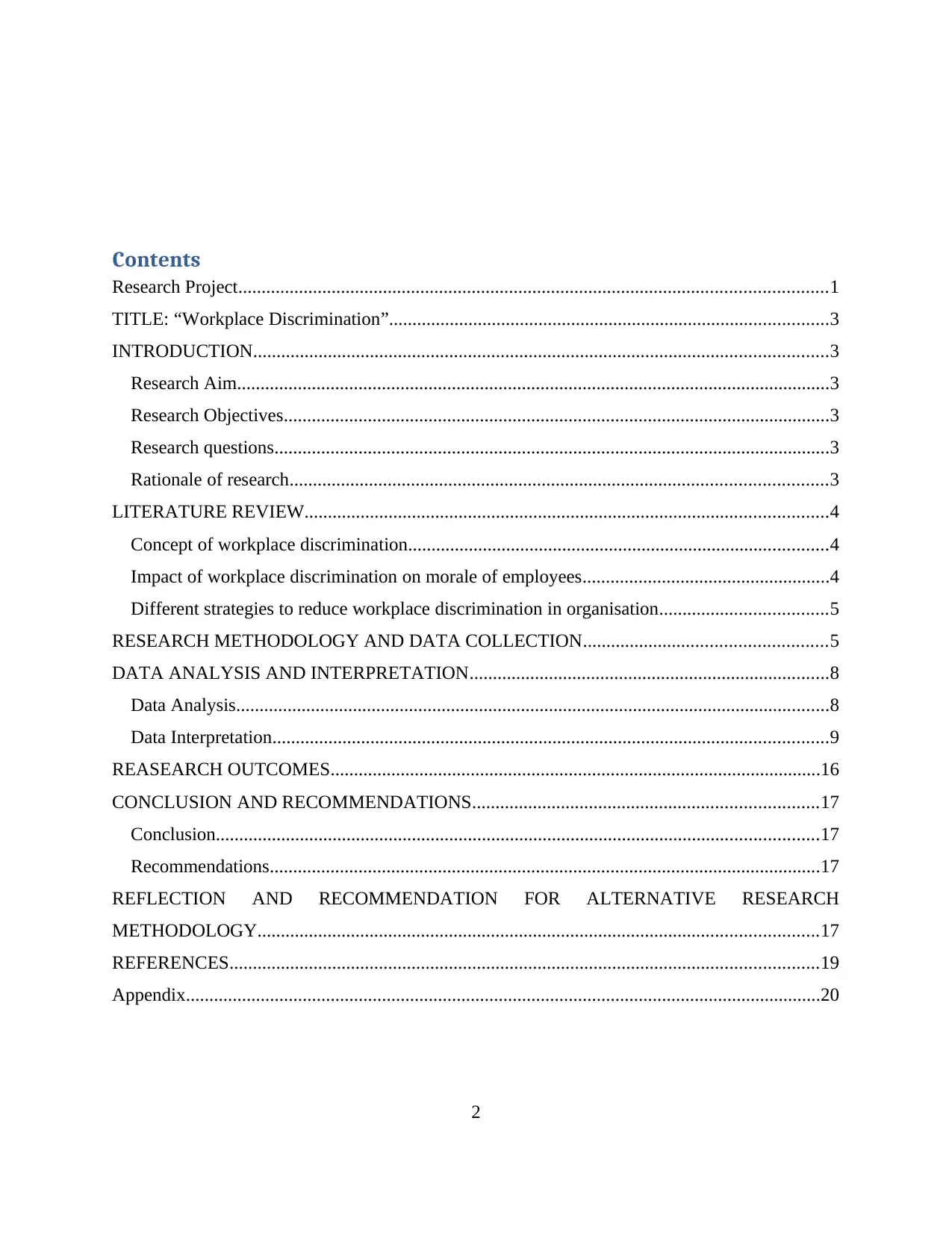
Contents
Research Project..............................................................................................................................1
TITLE: “Workplace Discrimination”..............................................................................................3
INTRODUCTION...........................................................................................................................3
Research Aim...............................................................................................................................3
Research Objectives.....................................................................................................................3
Research questions.......................................................................................................................3
Rationale of research...................................................................................................................3
LITERATURE REVIEW................................................................................................................4
Concept of workplace discrimination..........................................................................................4
Impact of workplace discrimination on morale of employees.....................................................4
Different strategies to reduce workplace discrimination in organisation....................................5
RESEARCH METHODOLOGY AND DATA COLLECTION....................................................5
DATA ANALYSIS AND INTERPRETATION.............................................................................8
Data Analysis...............................................................................................................................8
Data Interpretation.......................................................................................................................9
REASEARCH OUTCOMES.........................................................................................................16
CONCLUSION AND RECOMMENDATIONS..........................................................................17
Conclusion.................................................................................................................................17
Recommendations......................................................................................................................17
REFLECTION AND RECOMMENDATION FOR ALTERNATIVE RESEARCH
METHODOLOGY........................................................................................................................17
REFERENCES..............................................................................................................................19
Appendix........................................................................................................................................20
2
Research Project..............................................................................................................................1
TITLE: “Workplace Discrimination”..............................................................................................3
INTRODUCTION...........................................................................................................................3
Research Aim...............................................................................................................................3
Research Objectives.....................................................................................................................3
Research questions.......................................................................................................................3
Rationale of research...................................................................................................................3
LITERATURE REVIEW................................................................................................................4
Concept of workplace discrimination..........................................................................................4
Impact of workplace discrimination on morale of employees.....................................................4
Different strategies to reduce workplace discrimination in organisation....................................5
RESEARCH METHODOLOGY AND DATA COLLECTION....................................................5
DATA ANALYSIS AND INTERPRETATION.............................................................................8
Data Analysis...............................................................................................................................8
Data Interpretation.......................................................................................................................9
REASEARCH OUTCOMES.........................................................................................................16
CONCLUSION AND RECOMMENDATIONS..........................................................................17
Conclusion.................................................................................................................................17
Recommendations......................................................................................................................17
REFLECTION AND RECOMMENDATION FOR ALTERNATIVE RESEARCH
METHODOLOGY........................................................................................................................17
REFERENCES..............................................................................................................................19
Appendix........................................................................................................................................20
2
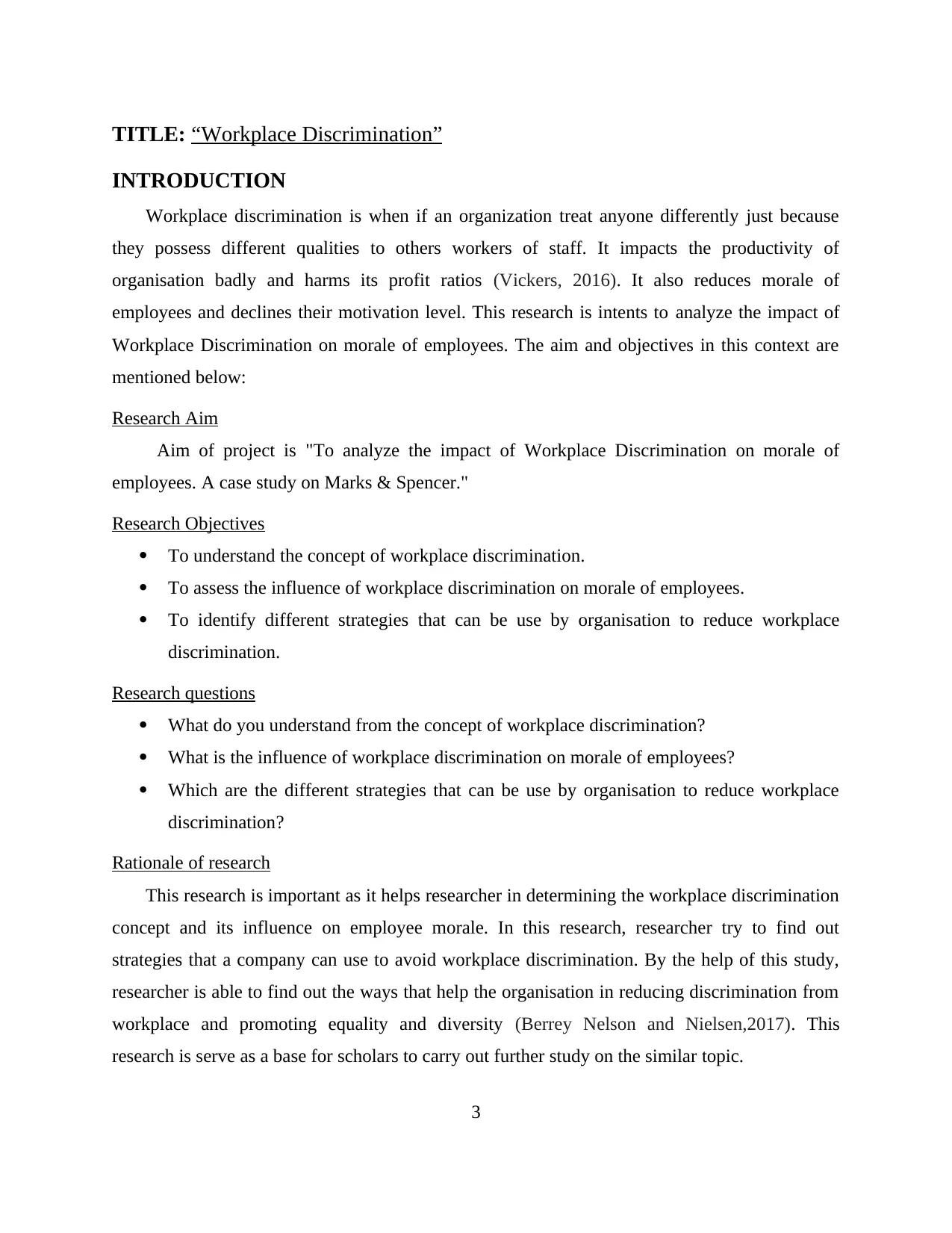
TITLE: “Workplace Discrimination”
INTRODUCTION
Workplace discrimination is when if an organization treat anyone differently just because
they possess different qualities to others workers of staff. It impacts the productivity of
organisation badly and harms its profit ratios (Vickers, 2016). It also reduces morale of
employees and declines their motivation level. This research is intents to analyze the impact of
Workplace Discrimination on morale of employees. The aim and objectives in this context are
mentioned below:
Research Aim
Aim of project is "To analyze the impact of Workplace Discrimination on morale of
employees. A case study on Marks & Spencer."
Research Objectives
To understand the concept of workplace discrimination.
To assess the influence of workplace discrimination on morale of employees.
To identify different strategies that can be use by organisation to reduce workplace
discrimination.
Research questions
What do you understand from the concept of workplace discrimination?
What is the influence of workplace discrimination on morale of employees?
Which are the different strategies that can be use by organisation to reduce workplace
discrimination?
Rationale of research
This research is important as it helps researcher in determining the workplace discrimination
concept and its influence on employee morale. In this research, researcher try to find out
strategies that a company can use to avoid workplace discrimination. By the help of this study,
researcher is able to find out the ways that help the organisation in reducing discrimination from
workplace and promoting equality and diversity (Berrey Nelson and Nielsen,2017). This
research is serve as a base for scholars to carry out further study on the similar topic.
3
INTRODUCTION
Workplace discrimination is when if an organization treat anyone differently just because
they possess different qualities to others workers of staff. It impacts the productivity of
organisation badly and harms its profit ratios (Vickers, 2016). It also reduces morale of
employees and declines their motivation level. This research is intents to analyze the impact of
Workplace Discrimination on morale of employees. The aim and objectives in this context are
mentioned below:
Research Aim
Aim of project is "To analyze the impact of Workplace Discrimination on morale of
employees. A case study on Marks & Spencer."
Research Objectives
To understand the concept of workplace discrimination.
To assess the influence of workplace discrimination on morale of employees.
To identify different strategies that can be use by organisation to reduce workplace
discrimination.
Research questions
What do you understand from the concept of workplace discrimination?
What is the influence of workplace discrimination on morale of employees?
Which are the different strategies that can be use by organisation to reduce workplace
discrimination?
Rationale of research
This research is important as it helps researcher in determining the workplace discrimination
concept and its influence on employee morale. In this research, researcher try to find out
strategies that a company can use to avoid workplace discrimination. By the help of this study,
researcher is able to find out the ways that help the organisation in reducing discrimination from
workplace and promoting equality and diversity (Berrey Nelson and Nielsen,2017). This
research is serve as a base for scholars to carry out further study on the similar topic.
3
⊘ This is a preview!⊘
Do you want full access?
Subscribe today to unlock all pages.

Trusted by 1+ million students worldwide
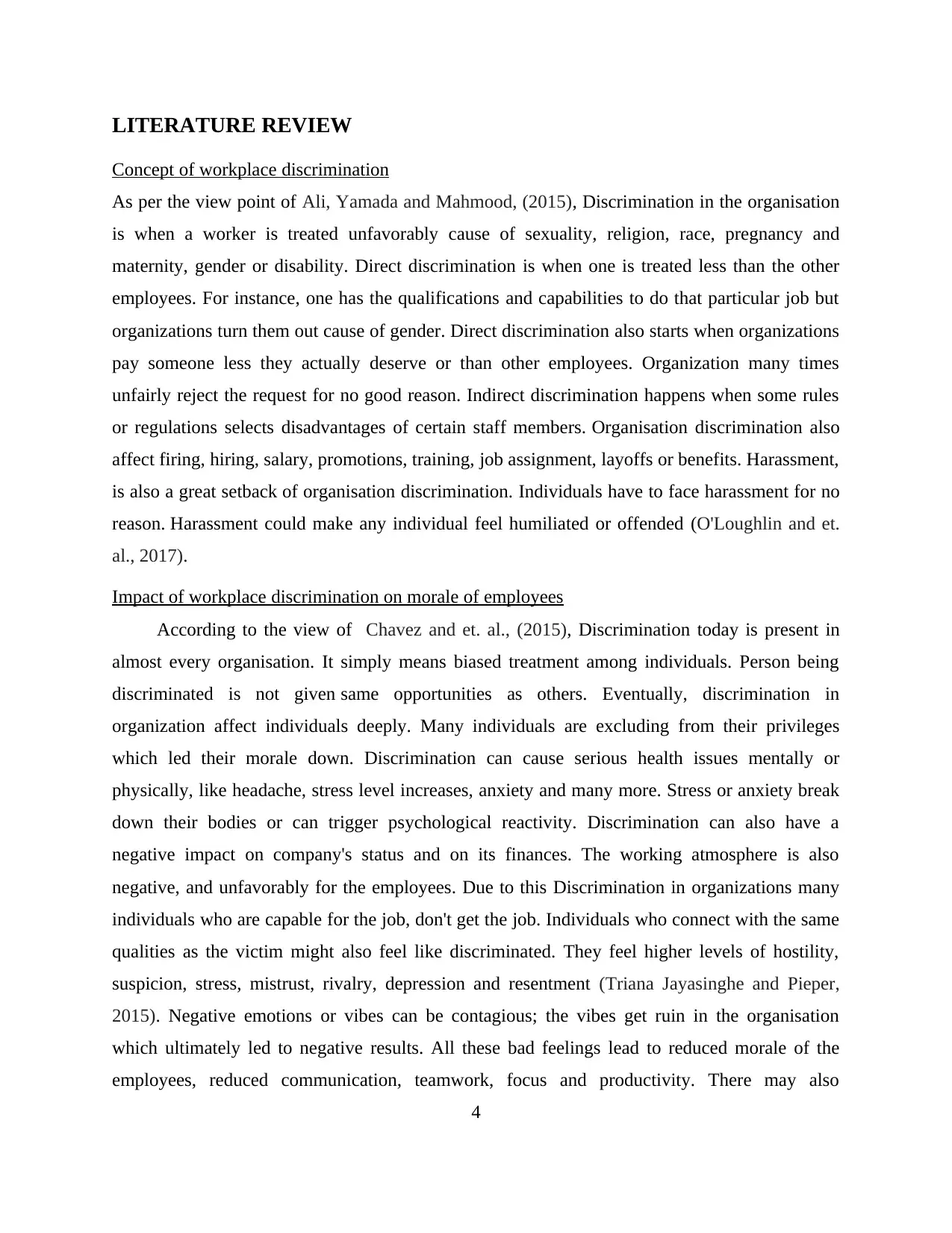
LITERATURE REVIEW
Concept of workplace discrimination
As per the view point of Ali, Yamada and Mahmood, (2015), Discrimination in the organisation
is when a worker is treated unfavorably cause of sexuality, religion, race, pregnancy and
maternity, gender or disability. Direct discrimination is when one is treated less than the other
employees. For instance, one has the qualifications and capabilities to do that particular job but
organizations turn them out cause of gender. Direct discrimination also starts when organizations
pay someone less they actually deserve or than other employees. Organization many times
unfairly reject the request for no good reason. Indirect discrimination happens when some rules
or regulations selects disadvantages of certain staff members. Organisation discrimination also
affect firing, hiring, salary, promotions, training, job assignment, layoffs or benefits. Harassment,
is also a great setback of organisation discrimination. Individuals have to face harassment for no
reason. Harassment could make any individual feel humiliated or offended (O'Loughlin and et.
al., 2017).
Impact of workplace discrimination on morale of employees
According to the view of Chavez and et. al., (2015), Discrimination today is present in
almost every organisation. It simply means biased treatment among individuals. Person being
discriminated is not given same opportunities as others. Eventually, discrimination in
organization affect individuals deeply. Many individuals are excluding from their privileges
which led their morale down. Discrimination can cause serious health issues mentally or
physically, like headache, stress level increases, anxiety and many more. Stress or anxiety break
down their bodies or can trigger psychological reactivity. Discrimination can also have a
negative impact on company's status and on its finances. The working atmosphere is also
negative, and unfavorably for the employees. Due to this Discrimination in organizations many
individuals who are capable for the job, don't get the job. Individuals who connect with the same
qualities as the victim might also feel like discriminated. They feel higher levels of hostility,
suspicion, stress, mistrust, rivalry, depression and resentment (Triana Jayasinghe and Pieper,
2015). Negative emotions or vibes can be contagious; the vibes get ruin in the organisation
which ultimately led to negative results. All these bad feelings lead to reduced morale of the
employees, reduced communication, teamwork, focus and productivity. There may also
4
Concept of workplace discrimination
As per the view point of Ali, Yamada and Mahmood, (2015), Discrimination in the organisation
is when a worker is treated unfavorably cause of sexuality, religion, race, pregnancy and
maternity, gender or disability. Direct discrimination is when one is treated less than the other
employees. For instance, one has the qualifications and capabilities to do that particular job but
organizations turn them out cause of gender. Direct discrimination also starts when organizations
pay someone less they actually deserve or than other employees. Organization many times
unfairly reject the request for no good reason. Indirect discrimination happens when some rules
or regulations selects disadvantages of certain staff members. Organisation discrimination also
affect firing, hiring, salary, promotions, training, job assignment, layoffs or benefits. Harassment,
is also a great setback of organisation discrimination. Individuals have to face harassment for no
reason. Harassment could make any individual feel humiliated or offended (O'Loughlin and et.
al., 2017).
Impact of workplace discrimination on morale of employees
According to the view of Chavez and et. al., (2015), Discrimination today is present in
almost every organisation. It simply means biased treatment among individuals. Person being
discriminated is not given same opportunities as others. Eventually, discrimination in
organization affect individuals deeply. Many individuals are excluding from their privileges
which led their morale down. Discrimination can cause serious health issues mentally or
physically, like headache, stress level increases, anxiety and many more. Stress or anxiety break
down their bodies or can trigger psychological reactivity. Discrimination can also have a
negative impact on company's status and on its finances. The working atmosphere is also
negative, and unfavorably for the employees. Due to this Discrimination in organizations many
individuals who are capable for the job, don't get the job. Individuals who connect with the same
qualities as the victim might also feel like discriminated. They feel higher levels of hostility,
suspicion, stress, mistrust, rivalry, depression and resentment (Triana Jayasinghe and Pieper,
2015). Negative emotions or vibes can be contagious; the vibes get ruin in the organisation
which ultimately led to negative results. All these bad feelings lead to reduced morale of the
employees, reduced communication, teamwork, focus and productivity. There may also
4
Paraphrase This Document
Need a fresh take? Get an instant paraphrase of this document with our AI Paraphraser
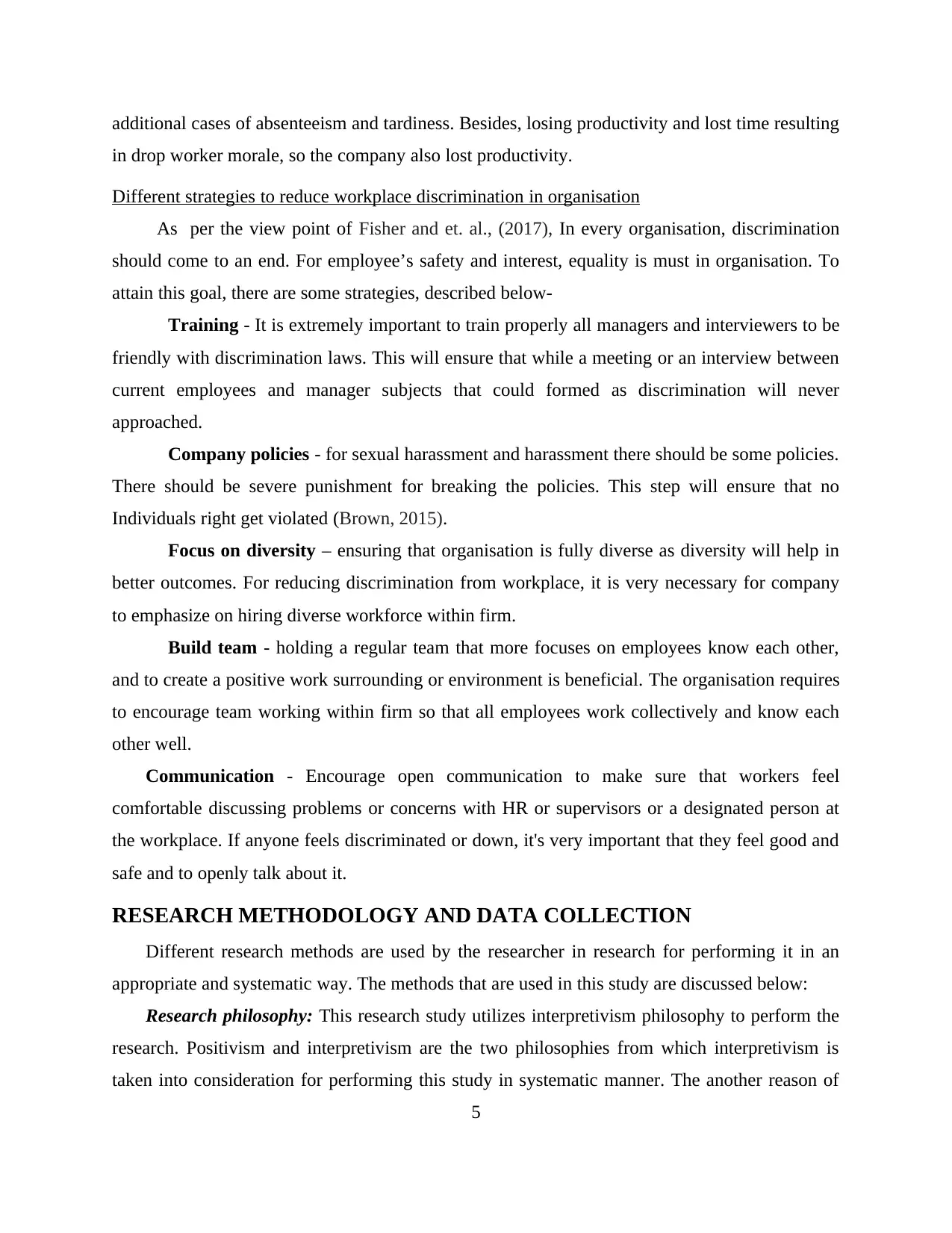
additional cases of absenteeism and tardiness. Besides, losing productivity and lost time resulting
in drop worker morale, so the company also lost productivity.
Different strategies to reduce workplace discrimination in organisation
As per the view point of Fisher and et. al., (2017), In every organisation, discrimination
should come to an end. For employee’s safety and interest, equality is must in organisation. To
attain this goal, there are some strategies, described below-
Training - It is extremely important to train properly all managers and interviewers to be
friendly with discrimination laws. This will ensure that while a meeting or an interview between
current employees and manager subjects that could formed as discrimination will never
approached.
Company policies - for sexual harassment and harassment there should be some policies.
There should be severe punishment for breaking the policies. This step will ensure that no
Individuals right get violated (Brown, 2015).
Focus on diversity – ensuring that organisation is fully diverse as diversity will help in
better outcomes. For reducing discrimination from workplace, it is very necessary for company
to emphasize on hiring diverse workforce within firm.
Build team - holding a regular team that more focuses on employees know each other,
and to create a positive work surrounding or environment is beneficial. The organisation requires
to encourage team working within firm so that all employees work collectively and know each
other well.
Communication - Encourage open communication to make sure that workers feel
comfortable discussing problems or concerns with HR or supervisors or a designated person at
the workplace. If anyone feels discriminated or down, it's very important that they feel good and
safe and to openly talk about it.
RESEARCH METHODOLOGY AND DATA COLLECTION
Different research methods are used by the researcher in research for performing it in an
appropriate and systematic way. The methods that are used in this study are discussed below:
Research philosophy: This research study utilizes interpretivism philosophy to perform the
research. Positivism and interpretivism are the two philosophies from which interpretivism is
taken into consideration for performing this study in systematic manner. The another reason of
5
in drop worker morale, so the company also lost productivity.
Different strategies to reduce workplace discrimination in organisation
As per the view point of Fisher and et. al., (2017), In every organisation, discrimination
should come to an end. For employee’s safety and interest, equality is must in organisation. To
attain this goal, there are some strategies, described below-
Training - It is extremely important to train properly all managers and interviewers to be
friendly with discrimination laws. This will ensure that while a meeting or an interview between
current employees and manager subjects that could formed as discrimination will never
approached.
Company policies - for sexual harassment and harassment there should be some policies.
There should be severe punishment for breaking the policies. This step will ensure that no
Individuals right get violated (Brown, 2015).
Focus on diversity – ensuring that organisation is fully diverse as diversity will help in
better outcomes. For reducing discrimination from workplace, it is very necessary for company
to emphasize on hiring diverse workforce within firm.
Build team - holding a regular team that more focuses on employees know each other,
and to create a positive work surrounding or environment is beneficial. The organisation requires
to encourage team working within firm so that all employees work collectively and know each
other well.
Communication - Encourage open communication to make sure that workers feel
comfortable discussing problems or concerns with HR or supervisors or a designated person at
the workplace. If anyone feels discriminated or down, it's very important that they feel good and
safe and to openly talk about it.
RESEARCH METHODOLOGY AND DATA COLLECTION
Different research methods are used by the researcher in research for performing it in an
appropriate and systematic way. The methods that are used in this study are discussed below:
Research philosophy: This research study utilizes interpretivism philosophy to perform the
research. Positivism and interpretivism are the two philosophies from which interpretivism is
taken into consideration for performing this study in systematic manner. The another reason of
5
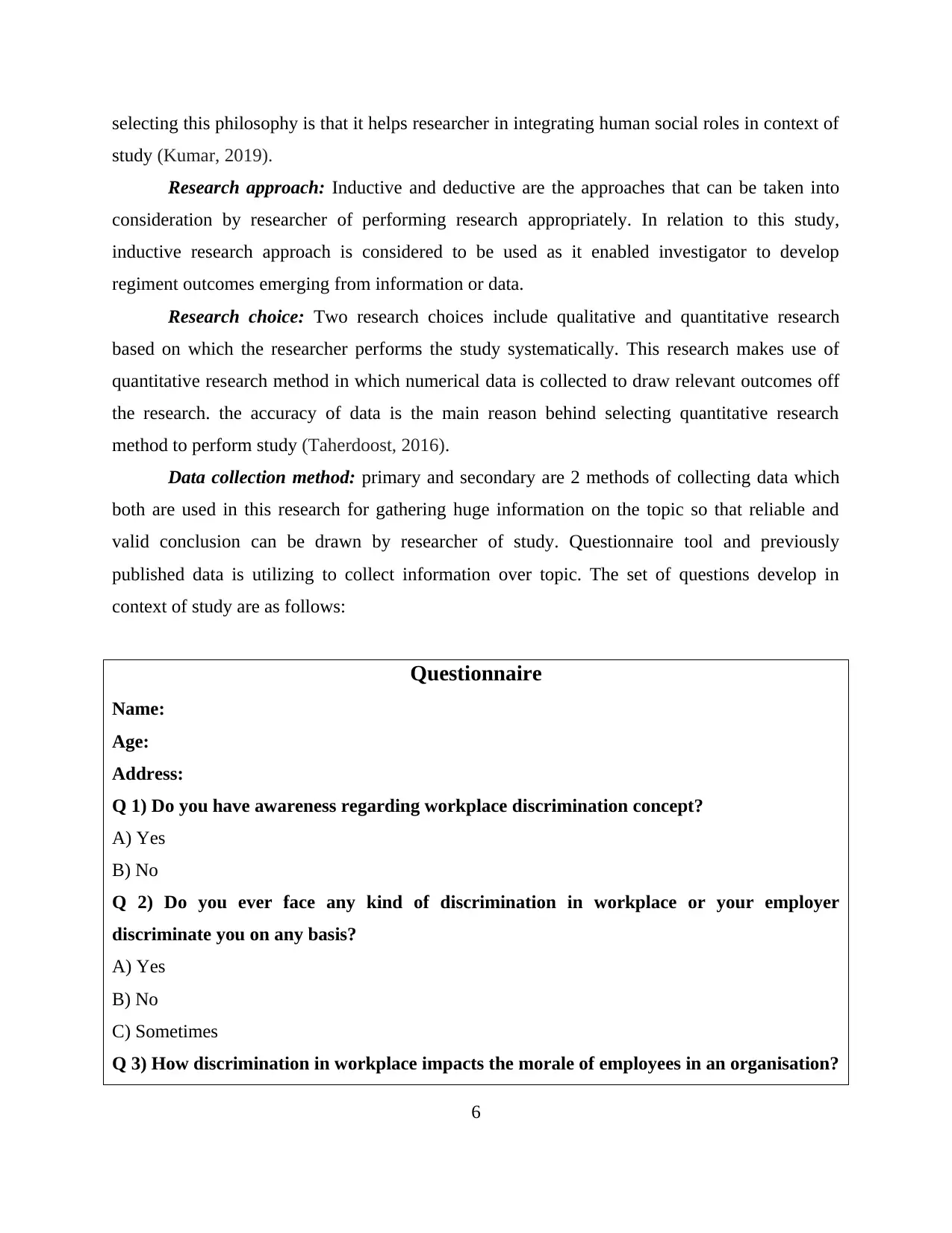
selecting this philosophy is that it helps researcher in integrating human social roles in context of
study (Kumar, 2019).
Research approach: Inductive and deductive are the approaches that can be taken into
consideration by researcher of performing research appropriately. In relation to this study,
inductive research approach is considered to be used as it enabled investigator to develop
regiment outcomes emerging from information or data.
Research choice: Two research choices include qualitative and quantitative research
based on which the researcher performs the study systematically. This research makes use of
quantitative research method in which numerical data is collected to draw relevant outcomes off
the research. the accuracy of data is the main reason behind selecting quantitative research
method to perform study (Taherdoost, 2016).
Data collection method: primary and secondary are 2 methods of collecting data which
both are used in this research for gathering huge information on the topic so that reliable and
valid conclusion can be drawn by researcher of study. Questionnaire tool and previously
published data is utilizing to collect information over topic. The set of questions develop in
context of study are as follows:
Questionnaire
Name:
Age:
Address:
Q 1) Do you have awareness regarding workplace discrimination concept?
A) Yes
B) No
Q 2) Do you ever face any kind of discrimination in workplace or your employer
discriminate you on any basis?
A) Yes
B) No
C) Sometimes
Q 3) How discrimination in workplace impacts the morale of employees in an organisation?
6
study (Kumar, 2019).
Research approach: Inductive and deductive are the approaches that can be taken into
consideration by researcher of performing research appropriately. In relation to this study,
inductive research approach is considered to be used as it enabled investigator to develop
regiment outcomes emerging from information or data.
Research choice: Two research choices include qualitative and quantitative research
based on which the researcher performs the study systematically. This research makes use of
quantitative research method in which numerical data is collected to draw relevant outcomes off
the research. the accuracy of data is the main reason behind selecting quantitative research
method to perform study (Taherdoost, 2016).
Data collection method: primary and secondary are 2 methods of collecting data which
both are used in this research for gathering huge information on the topic so that reliable and
valid conclusion can be drawn by researcher of study. Questionnaire tool and previously
published data is utilizing to collect information over topic. The set of questions develop in
context of study are as follows:
Questionnaire
Name:
Age:
Address:
Q 1) Do you have awareness regarding workplace discrimination concept?
A) Yes
B) No
Q 2) Do you ever face any kind of discrimination in workplace or your employer
discriminate you on any basis?
A) Yes
B) No
C) Sometimes
Q 3) How discrimination in workplace impacts the morale of employees in an organisation?
6
⊘ This is a preview!⊘
Do you want full access?
Subscribe today to unlock all pages.

Trusted by 1+ million students worldwide
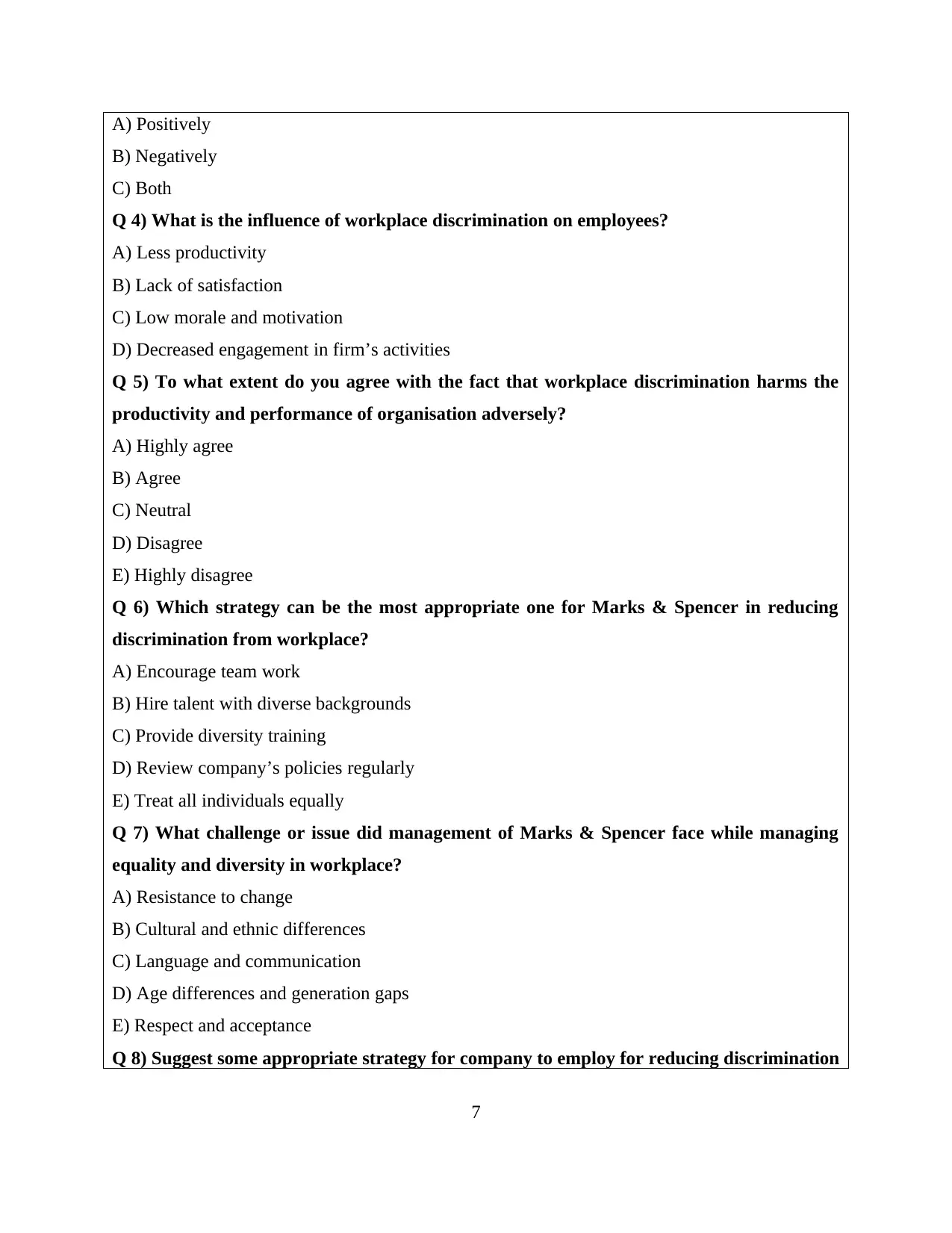
A) Positively
B) Negatively
C) Both
Q 4) What is the influence of workplace discrimination on employees?
A) Less productivity
B) Lack of satisfaction
C) Low morale and motivation
D) Decreased engagement in firm’s activities
Q 5) To what extent do you agree with the fact that workplace discrimination harms the
productivity and performance of organisation adversely?
A) Highly agree
B) Agree
C) Neutral
D) Disagree
E) Highly disagree
Q 6) Which strategy can be the most appropriate one for Marks & Spencer in reducing
discrimination from workplace?
A) Encourage team work
B) Hire talent with diverse backgrounds
C) Provide diversity training
D) Review company’s policies regularly
E) Treat all individuals equally
Q 7) What challenge or issue did management of Marks & Spencer face while managing
equality and diversity in workplace?
A) Resistance to change
B) Cultural and ethnic differences
C) Language and communication
D) Age differences and generation gaps
E) Respect and acceptance
Q 8) Suggest some appropriate strategy for company to employ for reducing discrimination
7
B) Negatively
C) Both
Q 4) What is the influence of workplace discrimination on employees?
A) Less productivity
B) Lack of satisfaction
C) Low morale and motivation
D) Decreased engagement in firm’s activities
Q 5) To what extent do you agree with the fact that workplace discrimination harms the
productivity and performance of organisation adversely?
A) Highly agree
B) Agree
C) Neutral
D) Disagree
E) Highly disagree
Q 6) Which strategy can be the most appropriate one for Marks & Spencer in reducing
discrimination from workplace?
A) Encourage team work
B) Hire talent with diverse backgrounds
C) Provide diversity training
D) Review company’s policies regularly
E) Treat all individuals equally
Q 7) What challenge or issue did management of Marks & Spencer face while managing
equality and diversity in workplace?
A) Resistance to change
B) Cultural and ethnic differences
C) Language and communication
D) Age differences and generation gaps
E) Respect and acceptance
Q 8) Suggest some appropriate strategy for company to employ for reducing discrimination
7
Paraphrase This Document
Need a fresh take? Get an instant paraphrase of this document with our AI Paraphraser
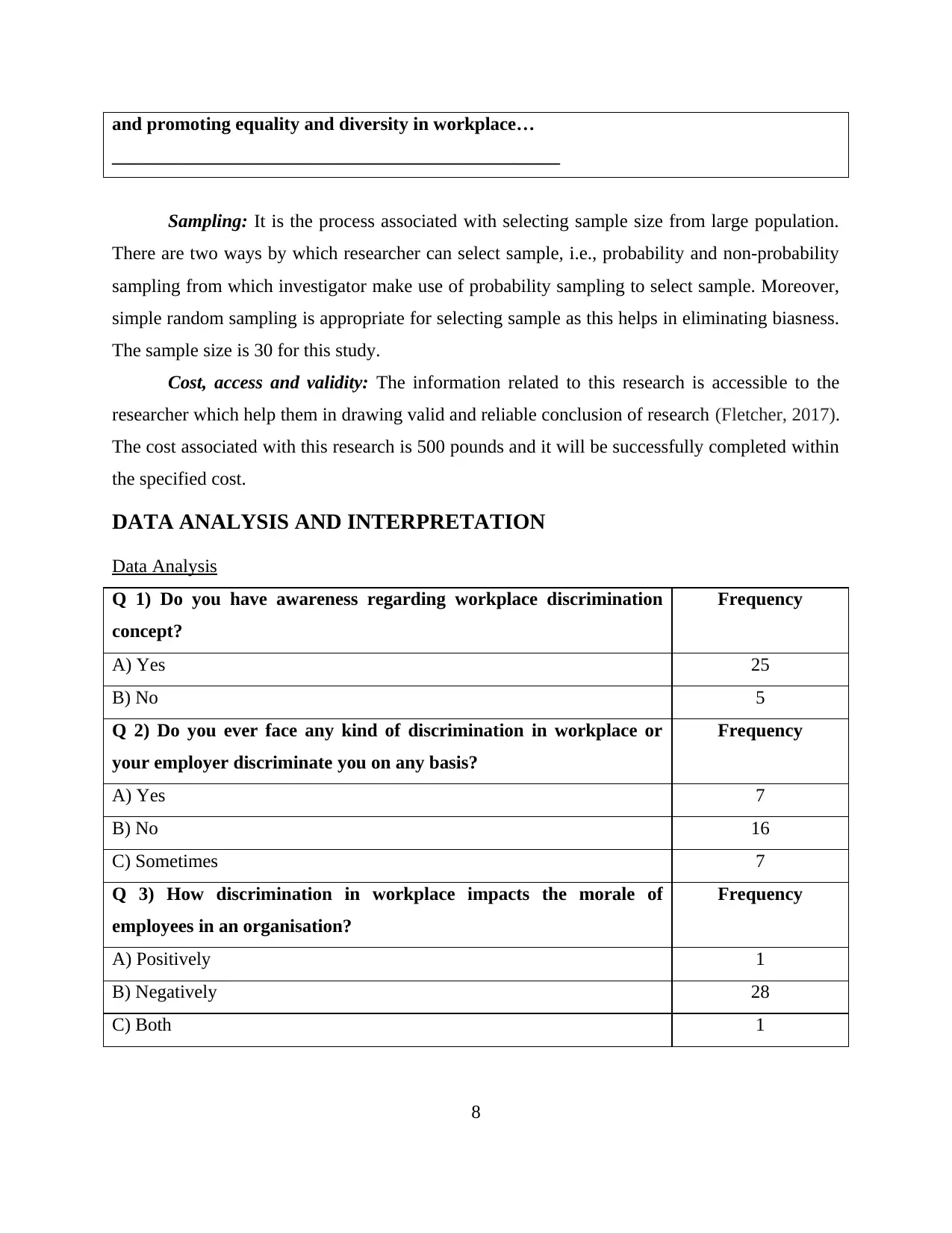
and promoting equality and diversity in workplace…
________________________________________________
Sampling: It is the process associated with selecting sample size from large population.
There are two ways by which researcher can select sample, i.e., probability and non-probability
sampling from which investigator make use of probability sampling to select sample. Moreover,
simple random sampling is appropriate for selecting sample as this helps in eliminating biasness.
The sample size is 30 for this study.
Cost, access and validity: The information related to this research is accessible to the
researcher which help them in drawing valid and reliable conclusion of research (Fletcher, 2017).
The cost associated with this research is 500 pounds and it will be successfully completed within
the specified cost.
DATA ANALYSIS AND INTERPRETATION
Data Analysis
Q 1) Do you have awareness regarding workplace discrimination
concept?
Frequency
A) Yes 25
B) No 5
Q 2) Do you ever face any kind of discrimination in workplace or
your employer discriminate you on any basis?
Frequency
A) Yes 7
B) No 16
C) Sometimes 7
Q 3) How discrimination in workplace impacts the morale of
employees in an organisation?
Frequency
A) Positively 1
B) Negatively 28
C) Both 1
8
________________________________________________
Sampling: It is the process associated with selecting sample size from large population.
There are two ways by which researcher can select sample, i.e., probability and non-probability
sampling from which investigator make use of probability sampling to select sample. Moreover,
simple random sampling is appropriate for selecting sample as this helps in eliminating biasness.
The sample size is 30 for this study.
Cost, access and validity: The information related to this research is accessible to the
researcher which help them in drawing valid and reliable conclusion of research (Fletcher, 2017).
The cost associated with this research is 500 pounds and it will be successfully completed within
the specified cost.
DATA ANALYSIS AND INTERPRETATION
Data Analysis
Q 1) Do you have awareness regarding workplace discrimination
concept?
Frequency
A) Yes 25
B) No 5
Q 2) Do you ever face any kind of discrimination in workplace or
your employer discriminate you on any basis?
Frequency
A) Yes 7
B) No 16
C) Sometimes 7
Q 3) How discrimination in workplace impacts the morale of
employees in an organisation?
Frequency
A) Positively 1
B) Negatively 28
C) Both 1
8
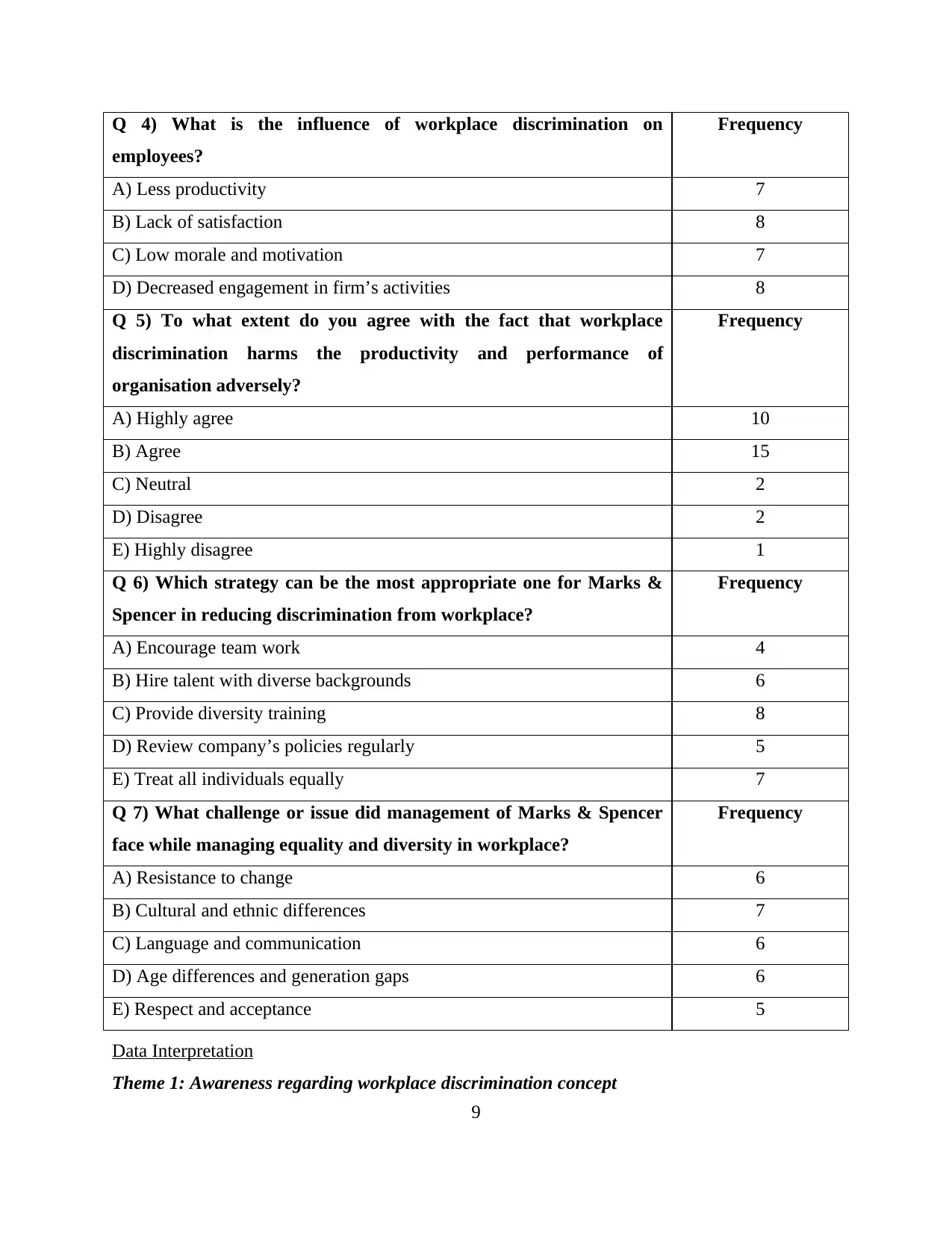
Q 4) What is the influence of workplace discrimination on
employees?
Frequency
A) Less productivity 7
B) Lack of satisfaction 8
C) Low morale and motivation 7
D) Decreased engagement in firm’s activities 8
Q 5) To what extent do you agree with the fact that workplace
discrimination harms the productivity and performance of
organisation adversely?
Frequency
A) Highly agree 10
B) Agree 15
C) Neutral 2
D) Disagree 2
E) Highly disagree 1
Q 6) Which strategy can be the most appropriate one for Marks &
Spencer in reducing discrimination from workplace?
Frequency
A) Encourage team work 4
B) Hire talent with diverse backgrounds 6
C) Provide diversity training 8
D) Review company’s policies regularly 5
E) Treat all individuals equally 7
Q 7) What challenge or issue did management of Marks & Spencer
face while managing equality and diversity in workplace?
Frequency
A) Resistance to change 6
B) Cultural and ethnic differences 7
C) Language and communication 6
D) Age differences and generation gaps 6
E) Respect and acceptance 5
Data Interpretation
Theme 1: Awareness regarding workplace discrimination concept
9
employees?
Frequency
A) Less productivity 7
B) Lack of satisfaction 8
C) Low morale and motivation 7
D) Decreased engagement in firm’s activities 8
Q 5) To what extent do you agree with the fact that workplace
discrimination harms the productivity and performance of
organisation adversely?
Frequency
A) Highly agree 10
B) Agree 15
C) Neutral 2
D) Disagree 2
E) Highly disagree 1
Q 6) Which strategy can be the most appropriate one for Marks &
Spencer in reducing discrimination from workplace?
Frequency
A) Encourage team work 4
B) Hire talent with diverse backgrounds 6
C) Provide diversity training 8
D) Review company’s policies regularly 5
E) Treat all individuals equally 7
Q 7) What challenge or issue did management of Marks & Spencer
face while managing equality and diversity in workplace?
Frequency
A) Resistance to change 6
B) Cultural and ethnic differences 7
C) Language and communication 6
D) Age differences and generation gaps 6
E) Respect and acceptance 5
Data Interpretation
Theme 1: Awareness regarding workplace discrimination concept
9
⊘ This is a preview!⊘
Do you want full access?
Subscribe today to unlock all pages.

Trusted by 1+ million students worldwide
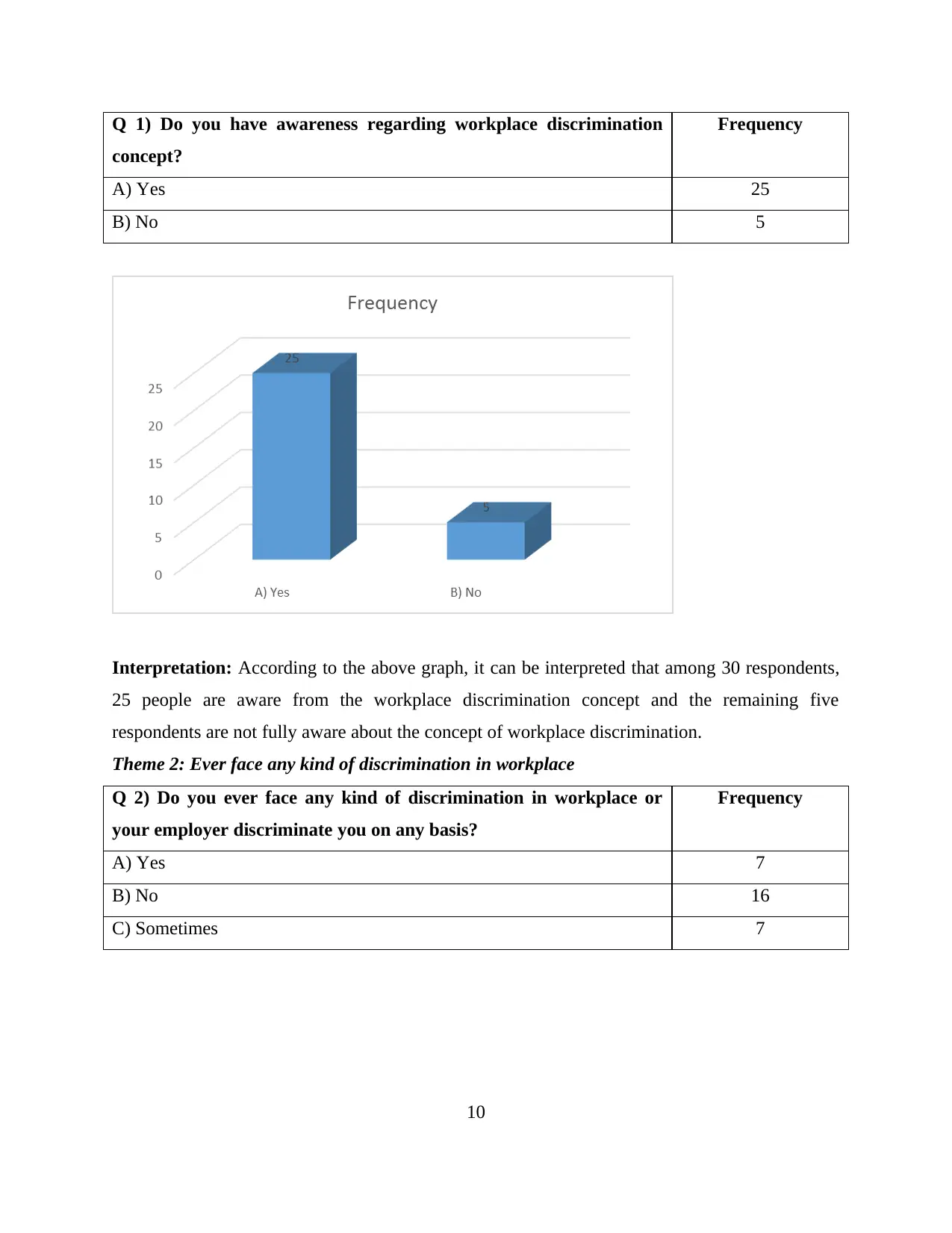
Q 1) Do you have awareness regarding workplace discrimination
concept?
Frequency
A) Yes 25
B) No 5
Interpretation: According to the above graph, it can be interpreted that among 30 respondents,
25 people are aware from the workplace discrimination concept and the remaining five
respondents are not fully aware about the concept of workplace discrimination.
Theme 2: Ever face any kind of discrimination in workplace
Q 2) Do you ever face any kind of discrimination in workplace or
your employer discriminate you on any basis?
Frequency
A) Yes 7
B) No 16
C) Sometimes 7
10
concept?
Frequency
A) Yes 25
B) No 5
Interpretation: According to the above graph, it can be interpreted that among 30 respondents,
25 people are aware from the workplace discrimination concept and the remaining five
respondents are not fully aware about the concept of workplace discrimination.
Theme 2: Ever face any kind of discrimination in workplace
Q 2) Do you ever face any kind of discrimination in workplace or
your employer discriminate you on any basis?
Frequency
A) Yes 7
B) No 16
C) Sometimes 7
10
Paraphrase This Document
Need a fresh take? Get an instant paraphrase of this document with our AI Paraphraser

Interpretation: The above graph depicts that, out of 30 respondents, seven said that yes they
face discrimination in workplace and their employer discriminate them on the basis of age,
gender, religion, culture etc. 16 respondents said that they are not discriminated by their
employer and the remaining seven said that they sometimes feel to be discriminated at
workplace.
Theme 3: The way discrimination in workplace impacts the morale of employees in an
organisation
Q 3) How discrimination in workplace impacts the morale of
employees in an organisation?
Frequency
A) Positively 1
B) Negatively 28
C) Both 1
11
face discrimination in workplace and their employer discriminate them on the basis of age,
gender, religion, culture etc. 16 respondents said that they are not discriminated by their
employer and the remaining seven said that they sometimes feel to be discriminated at
workplace.
Theme 3: The way discrimination in workplace impacts the morale of employees in an
organisation
Q 3) How discrimination in workplace impacts the morale of
employees in an organisation?
Frequency
A) Positively 1
B) Negatively 28
C) Both 1
11

Interpretation: According to the above chart, it is interpreted that out of 30 respondents, one
said that discrimination in workplace impacts the morale of employees positively, 28
respondents said that it impacts negatively on the morale of employees and the remaining one
said that it impacts both positively and negatively.
Theme 4: Influence of workplace discrimination on employees
Q 4) What is the influence of workplace discrimination on
employees?
Frequency
A) Less productivity 7
B) Lack of satisfaction 8
C) Low morale and motivation 7
D) Decreased engagement in firm’s activities 8
12
said that discrimination in workplace impacts the morale of employees positively, 28
respondents said that it impacts negatively on the morale of employees and the remaining one
said that it impacts both positively and negatively.
Theme 4: Influence of workplace discrimination on employees
Q 4) What is the influence of workplace discrimination on
employees?
Frequency
A) Less productivity 7
B) Lack of satisfaction 8
C) Low morale and motivation 7
D) Decreased engagement in firm’s activities 8
12
⊘ This is a preview!⊘
Do you want full access?
Subscribe today to unlock all pages.

Trusted by 1+ million students worldwide
1 out of 31
Related Documents
Your All-in-One AI-Powered Toolkit for Academic Success.
+13062052269
info@desklib.com
Available 24*7 on WhatsApp / Email
![[object Object]](/_next/static/media/star-bottom.7253800d.svg)
Unlock your academic potential
Copyright © 2020–2025 A2Z Services. All Rights Reserved. Developed and managed by ZUCOL.





